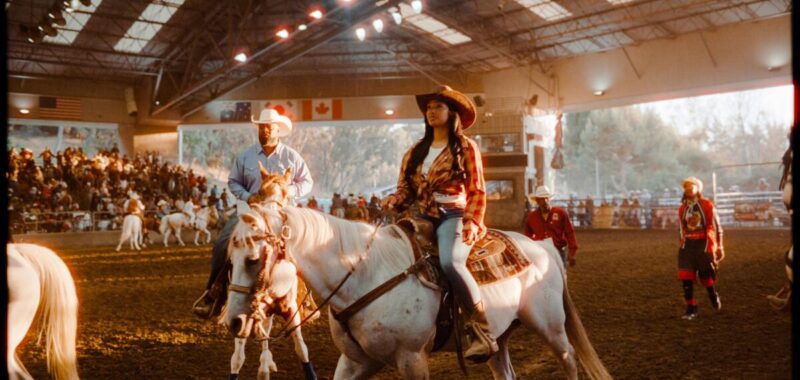As someone who’s spent the better part of a decade living and photographing in Los Angeles, few things felt more exciting than capturing my first rodeo here and the Black riders who personified athleticism, passion and courage. As part of my journey over the past several years to find Black faces and places to document in ways only my ancestors could have dreamt of — under the project name Black Magic — I went in search for Black horseback riders and rodeo participants of all ages chasing their desire to ride, jump, lasso and embody the spirit of the old West while making it new again.
Starting in January 2024, this journey has led me to the small-but-mighty city of Tulsa, Okla. Known by most as the site of the 1921 Race Massacre and historically Black Greenwood District, Tulsa and the greater state of Oklahoma is home to some of the richest pockets of rodeo and Western culture in the country, just ask the creators of the 2023 film “Riding Legacy (An Oklahoma Black Cowboy Story)” directed and produced by Kian Taylor, Jay Ridley, Nicole Jocleen and Brittany Taylor. Unlike Tulsa, L.A. is typically one of the last places people might assume any rodeo culture exists, let alone a Black rodeo. Little did I know upon entering the Industry Hills Expo Center in West Covina recently to witness the Bill Pickett Invitational Rodeo for the first time last year, I had stumbled onto an event where Black communities across the country congregate yearly for a day of fun, food, riding and fellowship.
A photographer’s role doesn’t solely depend on our ability to see things as they are. Our job offers the opportunity to, as Solange iconically put it, see things we’ve also imagined to add an air of whimsy or fantasy to the moments we’ve intentionally frozen in time. Upon entry to the parking lot of the 40th Annual Bill Pickett Invitational Rodeo you are immediately tasked with tapping into all of your senses with an acuity we only enlist during a heightened sense of excitement. You smell the rodeo well before you approach entry gates. The assortment of fried, smothered, pickled or barbecued options guide your steps into the gentlest of food comas. Sounds of Beyoncé and Earth, Wind & Fire reach your eardrums and awaken the alto in all of us to join the choir of thousands around you. Depending on how close you end up sitting, you may even taste some of the dirt thrown from the ring as champion cowgirl Kandra Demery whirls about the strategically placed obstacles during her barrel races. Without a doubt, you’ll feel your heart racing watching the steer wrestlers hurl themselves from atop their horses to wrangle bovine companions in time to secure their victory.
With a camera in hand, I challenged myself to capture the synchronized electric slides, dozens upon dozens of Black folk on horseback in the arena for the Grand Entry trailed by the largest Pan-African flag you’ve ever seen carried by rising star Paris Wilburd. I aimed to document the fast twitch movements of each bull trying to dismount daredevils like my rodeo twin Au’Vion Horton, contributing to the treasure trove of Black culture and keeping my finger on the shutter button to get the best shot.
As the popularity of Black rodeo culture has grown in the last year, it has opened doors for countless Black folk to deepen their relationship with themselves through seeing these historic traditions and families that have upheld them for generations. One of the first faces I saw upon entry to the arena in L.A. is the rodeo’s Merchandise Manager Kristi Demery, a rodeo mom for almost 30 years from Okmulgee, Okla. now living in the Beggs, Okla. We spoke of the reverence this community has for their lifestyle and the legacy left by Bill Pickett Rodeo’s founder Lu Vason in 1984 that caused millions of Black folk to truly understand our place in Western culture.
Fast forward one year, Demery has become somewhat of a rodeo mother to me as we’ve seen each other at numerous rodeos around Oklahoma. Each rodeo is akin to a family reunion, a side glance across the bleachers can turn into an hour long conversation recalling how each other’s mothers are doing with smiles cheek to cheek and the promise of leaving with a plate of your favorite catfish.
After experiencing the captivating events a year prior, I arranged for my own reunion of sorts with around 35 friends and new faces within the Black creative community to gather and bear witness to this momentous anniversary. I think of Kilyn Hayes, Devyn Hayes and Maya Johnson for example. These young Black women from the Inland Empire and their families congregate in the VIP section of the arena to break bread, share laughter and, of course, take photos among the sea of Black rodeo enthusiasts each year. I’ve had the pleasure of photographing and spending time with them and their families for the second year in a row. Even if you don’t arrive at the show with your family, you’re almost guaranteed to feel close to kin with someone by the time you leave. The magnetic energy and gleaming smile of rodeo MC Tiffany Guess will certainly make sure of it.
The Bill Pickett Rodeo is a celebration of the culture that extends far beyond the bright lights and line dances. For 40 years, generations of people have come from far corners of America to honor the contributions made by Black people in Western culture. The dedicated staff that puts on the traveling rodeo tour reminds us as each rodeo concludes why it truly is “The Greatest Show on Dirt.”
Here’s a few more images from the Bill Pickett Invitational Rodeo in Los Angeles:

